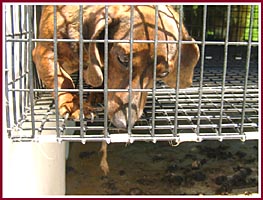 Rulemaking Process: ATCP 16 - Regulation of Dog Sellers Rulemaking Process: ATCP 16 - Regulation of Dog Sellers
 1. On
January 13, 2010, the DATCP Board approved the Scope of Proposed Rulemaking
Statement. This begins the process for rulemaking. 1. On
January 13, 2010, the DATCP Board approved the Scope of Proposed Rulemaking
Statement. This begins the process for rulemaking.
2.
The Advisory Committee will have until approximately the end of
June to complete its work in assisting the Division to develop the ATCP 16
rule, implementing s. 173.41, Wis. Stats., regarding the licensing and
regulation of dog sellers
3. By July 21,
2010, the draft of the rule must be sent to DATCP's Chief Legal Counsel for
review. This includes not only the draft rule language, but also the following:
a. Plain Language Analysis
b. Fiscal Estimate - objectively
describing the rule's anticipated fiscal effect on DATCP and other state and
local units of government
c. Small Business Analysis - analyze
the rules to determine the effect on small business and attempt to minimize any
adverse impacts. .
4. On August
11, 2010, the DATCP Board will be asked approve the draft for public hearings
at its meeting.
5. If the
Board approves the hearing draft, the Division must send the draft to the
Legislative Council Rules Clearinghouse for review, prior to DATCP holding
public hearings on the rule. The Clearinghouse will review the rule for
compliance with legal and drafting requirements. The Clearinghouse has 20
working days to review the proposed rule.
6. At the same
time as the Clearinghouse is reviewing the rule, DATCP may publish a formal
hearing notice, describing the proposed rule and announcing the scheduled
hearing dates, times and locations.
 7. In October, 2010,
the Division will hold public hearings on ATCP 16. These hearings will be held
at different locations in the state and will include an opening statement by
Division staff, with a brief summary of the background and contents of the
proposed rule. There will be an audio recording of the hearing and provision
for submitting written comments. A record will be made of all the hearings, as
part of the rule file. 7. In October, 2010,
the Division will hold public hearings on ATCP 16. These hearings will be held
at different locations in the state and will include an opening statement by
Division staff, with a brief summary of the background and contents of the
proposed rule. There will be an audio recording of the hearing and provision
for submitting written comments. A record will be made of all the hearings, as
part of the rule file.
8. By November
17, 2010, the final rule must be sent to DATCP's Chief Legal Counsel for
review. The analysis must address suggestions made by the Legislative Council
Rules Clearinghouse report and at public hearings, including those suggestions
that were incorporated in the final rule and those that were not, and why or
why not.
9. On December
8, 2010, the DATCP Board will be asked to approve the final draft of ATCP 16.
10. After the
Board approves the final draft rule, DATCP must refer the rule for Legislative
committee review. Within 7 days after DATCP refers the rule to the Legislature,
the presiding officer in each house refers the rule to one standing committee
in that house. Each standing committee has 30 days to review the rule, with a
possible extension of 30 days.
11. Once the
review period is complete, DATCP may adopt the rule, by having the Secretary
sign the rule and filing certified copies. The rule will not take effect until
the first day of the month following publication in the Wisconsin
Administrative Register.
12. If this
rule is filed by February 12, 2011, it will be published on March 31, 2011 with
a general effective date of April 1, 2011. However, if the rule has a
significant economic impact on small business, then the rule as it applies to
small businesses is effective on June 1, 2011. The program is scheduled to
begin, with the rule in effect, on July 1, 2011.
The
Wisconsin Legislature website features an official record of the 13 October
2009 joint committee public hearing. This includes lists of those who spoke or
registered for or against the bill. (Note: please see link bar at left; scroll
down to "AB250" and click.)
 Printer-friendly version (pdf) Printer-friendly version (pdf) 
|